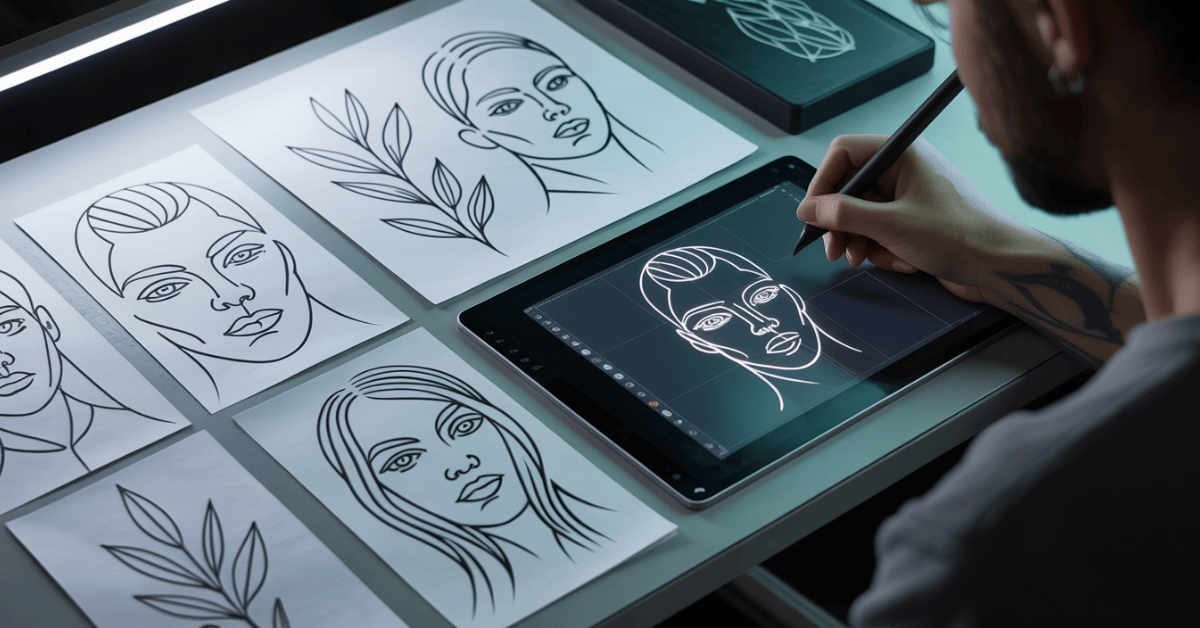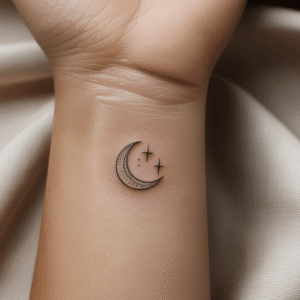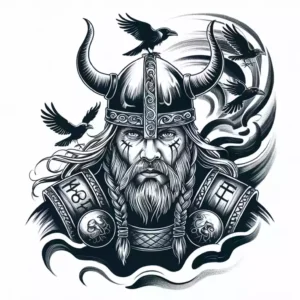The art of tattooing starts with a key step: making a stencil. This stencil guides the tattoo artist. It’s crucial for getting detailed designs right on the skin.
Looking ahead to 2025, tattooing will see new emerging styles and best practices. Knowing these trends is important for tattoo artists and fans. The stencil is key in shaping these trends.
Key Takeaways
- Emerging styles in tattoo designs for 2025
- Best practices for creating effective stencils
- The importance of stencils in the tattooing process
- Popular tattoo designs and their stencil outlines
- Techniques for improving stencil accuracy
The Evolution of Tattoo Stencil Outlines: A 2025 Perspective
In 2025, tattooing is getting a boost from new stencil techniques. These changes come from tech progress and new artistic needs.
Historical Context of Tattoo Stenciling
Tattoo stenciling has a long history. At first, artists used freehand or carbon paper to make stencils.
From Carbon Paper to Digital Methods
Now, we’ve moved from carbon paper to digital tools. This change has made stencils more precise and accurate.
The Digital Revolution in Stencil Creation
Digital tech has changed the tattoo world. It brings new tools and ways to make stencils.
How Technology Has Transformed Precision
Technology has made stencils more precise. Digital tools let artists create detailed designs easily.
| Technique | Precision Level | Artist Preference |
|---|---|---|
| Carbon Paper | Moderate | Traditionalists |
| Digital Methods | High | Modern Artists |
As tech keeps improving, tattoo artists are trying new things. The future of tattoo stencils looks bright, thanks to digital advancements.
Tattoo Stencil Outline Trends 2025: What’s Changing in the Industry
As we enter 2025, tattoo art is seeing big changes in stencil outlines. The focus is on more detailed and complex designs. This is thanks to new tech and what people want.
Minimalist Precision Outlines
Minimalist precision outlines are becoming popular. They feature clean lines and are simple. People like them because they are elegant yet subtle.
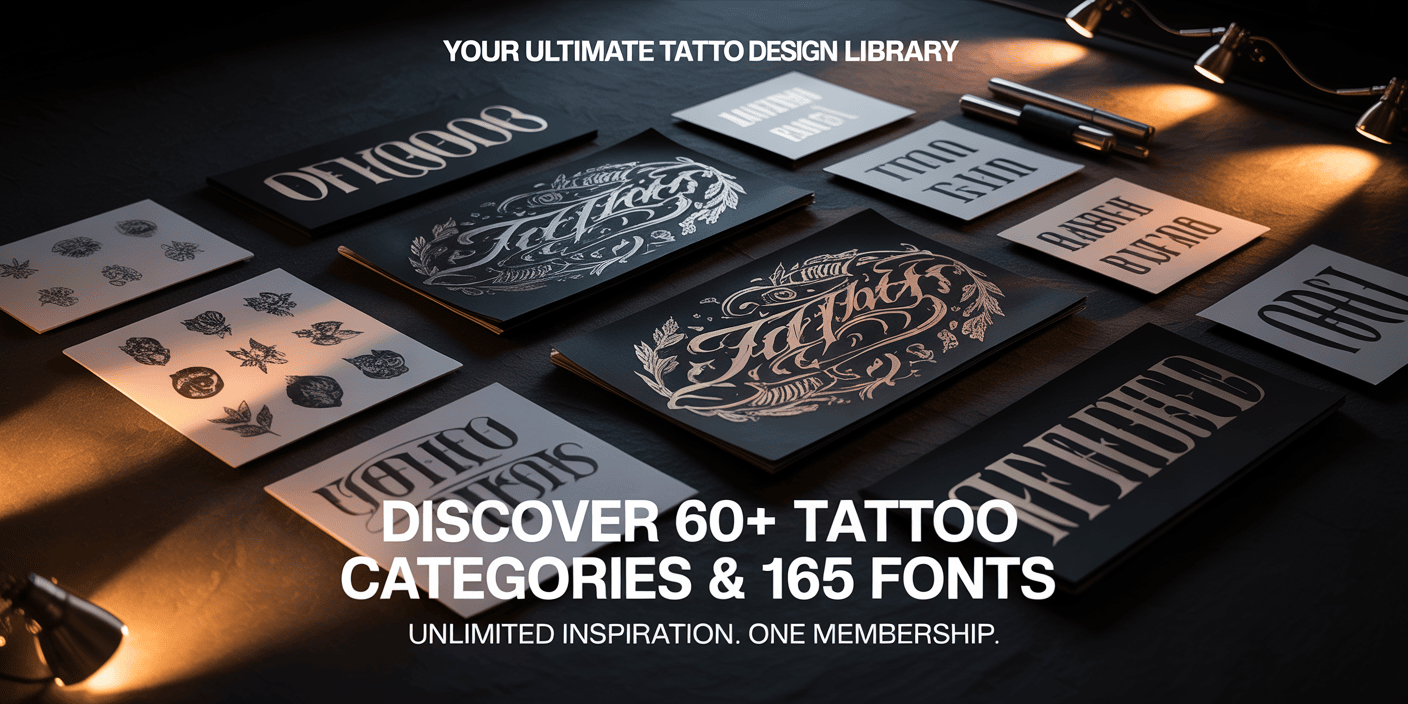
Single-Line Techniques
Single-line techniques are also on the rise. Artists use one line to make detailed designs. It’s a skill that shows off their talent.
Hyper-Detailed Micro Stencils
Hyper-detailed micro stencils are also getting more attention. They let artists make small, detailed designs that were hard to do before.
Tools for Microscopic Precision
Artists use special tools for these small designs. These tools help them create detailed work in tiny spaces. They’re changing how small designs are made.
Geometric Evolution in Outline Work
Geometric patterns are coming back. Artists use math to make symmetrical and detailed designs. This makes tattoos stand out.
Mathematical Approaches to Symmetry
Math helps artists make designs perfectly symmetrical. This adds depth and beauty to their work. As one artist says,
“The use of mathematical approaches in tattoo design has opened up new possibilities for creating intricate, symmetrical patterns that clients love.”
If you’re into tattoos, 2025 is full of new styles to try. Whether you like simple designs or detailed ones, there’s something for everyone.
Emerging Tattoo Styles Demanding New Stencil Approaches
Exploring the latest in tattoo art shows that new styles are changing stencil techniques. The tattoo world is seeing more creative designs. Artists must now use new methods to keep up.
Bio-Organic and Biomechanical Designs
Bio-organic and biomechanical tattoos are becoming more popular. They mix natural shapes with mechanical parts. Stencils for these need to capture both the softness of nature and the sharpness of machines.
Fluid vs. Mechanical Line Requirements
Stencils for bio-organic tattoos must balance smooth lines with sharp details. “The secret to great bio-organic stencils is mixing smooth curves with precise lines,” says a top tattoo artist. This mix is key to the look.
Abstract Expressionism in Tattoo Art
Abstract expressionism is also growing in tattoo art. Artists are using bold, free designs that break away from traditional forms. Stencils for these must be flexible yet strong.
Balancing Spontaneity with Structure
The challenge with abstract tattoos is mixing freedom with structure. Artists need stencils that are flexible but keep the design balanced.
Cultural Fusion Patterns
Cultural fusion is another trend, blending traditional and modern styles. Stencils for these tattoos must mix different patterns smoothly.
Blending Traditional Elements with Modern Techniques
Creating stencils for cultural fusion tattoos means mixing old and new. Artists need to understand many cultures and blend them well.
Exploring these new tattoo styles shows the need for new stencil methods. Tattoo artists can keep growing by adapting to these trends.
How Stencil Outline Needs Change by Tattoo Style

Exploring different tattoo styles shows that each needs a unique stencil approach. Stencil techniques are key in tattoo art. They vary in detail, precision, and creativity based on the style.
Traditional vs. Neo-Traditional Requirements
Traditional and neo-traditional tattoos have different stencil needs. Traditional tattoos need bold lines and classic images. Neo-traditional tattoos, on the other hand, have intricate details and varied line weights.
Bold Lines vs. Varied Weights
Traditional tattoos require stencils with bold, consistent lines. Neo-traditional tattoos, though, need stencils for varied line weights. This adds depth and character to the tattoo.
Realism and Hyper-Realism Stencil Techniques
Realism and hyper-realism tattoos need precise stencils. The aim is to create a detailed, lifelike image on the skin.
Detail Preservation in Transfer Process
Keeping the details of realistic designs intact during transfer is crucial. Using high-quality transfer paper and ensuring the stencil isn’t distorted during application is vital.
Watercolor and Illustrative Style Considerations
Watercolor and illustrative tattoos need stencils that capture their artistic nature. The stencil should allow for soft edges and blended colors.
Creating Frameworks for Fluid Designs
For watercolor and illustrative styles, a stencil that acts as a framework is essential. It must balance detail with the freedom to create soft, blended edges during tattooing.
Understanding the specific stencil needs of different tattoo styles can enhance your craft. This way, you can deliver high-quality tattoos that meet your clients’ expectations.
Digital Innovation: Tech-Driven Stencil Creation Methods
The tattoo world is changing fast, thanks to new digital tools for making stencils. Artists are now using tech to improve their work, from the first sketch to the final tattoo.
AI-Assisted Stencil Generation
Artificial intelligence is changing tattoos by helping make stencils. AI algorithms look at designs, adjust for skin, and spot potential tattoo problems.
Machine Learning for Style Adaptation
Machine learning, part of AI, lets artists tailor tattoos to what clients want. This means artists can create designs that fit the client’s style perfectly.
3D Modeling for Complex Body Contours
3D modelling helps artists plan tattoos for tricky body shapes. It makes sure the tattoo fits the body perfectly, even for hard-to-tattoo spots.
Mapping Designs to Non-Flat Surfaces
3D modelling also lets artists design tattoos for curved parts of the body. This way, tattoos look great on any body shape.
Augmented Reality Stencil Placement
Augmented reality (AR) lets people see tattoos on themselves before getting them. It’s a way to try out tattoos without committing to ink.
Virtual Try-Before-You-Apply Solutions
AR makes it easy to try tattoos virtually. This makes clients happier and reduces the chance of not liking the tattoo.
These new tech tools are making tattoos better and more creative. As tech keeps getting better, we’ll see even more cool tattoo-making tools.
Sustainable Practices in Tattoo Stencil Production

The future of tattooing is not just about art. It’s also about using sustainable practices, starting with stencil production. As tattooing grows, so does its impact on the environment. Eco-friendly methods are now a must.
Eco-Friendly Stencil Materials
Creating stencils is a big focus. Traditional products often have harmful chemicals and don’t break down easily.
Biodegradable Alternatives to Traditional Products
Using biodegradable stencil materials helps a lot. These materials are made from natural things that break down quickly. This cuts down on waste and pollution.
Reducing Waste in the Stencil Process
It’s not just about the materials. Reducing waste is also key to making stencils sustainable.
Digital Proofing to Minimize Paper Usage
Digital proofing is a big help. It lets artists check and approve designs online. This cuts down on paper use, reducing waste and making the design process smoother.
Professional Stencil Techniques for 2025
In 2025, tattoo artists are getting better at stencil techniques. They aim for more detail and precision. New tech and creative ideas are leading this change. We’ll look at the latest methods, like multi-layer stenciling, freehand hybrids, and precision mapping for big projects.
Multi-Layer Stenciling for Complex Designs
Multi-layer stenciling is now popular for detailed tattoos. It breaks down designs into layers, each with its own stencil.
Color Separation and Registration Methods
Getting colors right and lining up layers is key for multi-layer stenciling. Artists use special software for this.
- Utilize software for color separation
- Ensure precise registration between layers
- Test stencils before application
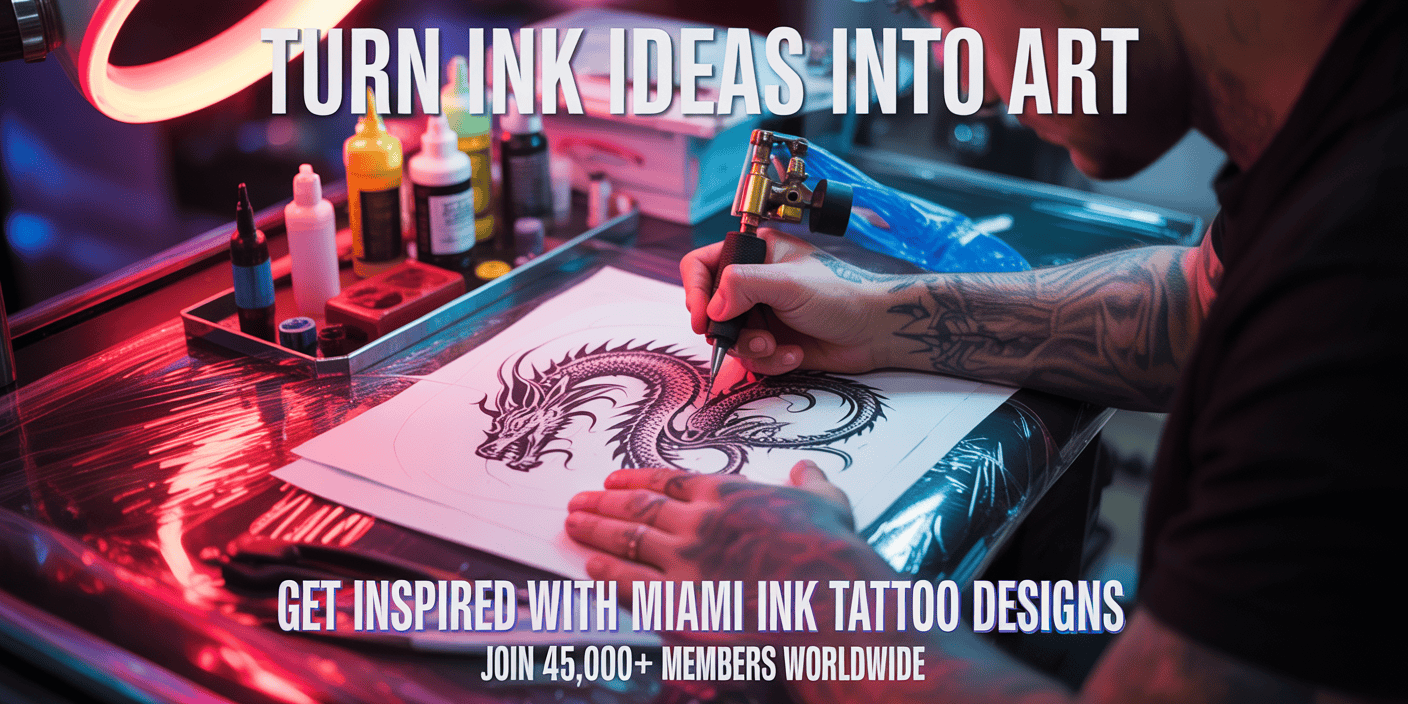
Freehand Hybrid Approaches
Freehand hybrids mix stencil use with drawing skills. This gives artists more freedom and creativity.
Combining Stencil Foundations with Artistic Freedom
This method starts with a stencil and then adds unique freehand touches. It lets artists add personal flair.
Example:“Artists can use stencils for the basic outline and then add intricate details freehand.”
Precision Mapping for Large-Scale Projects
Precision mapping is vital for big tattoos. It makes sure the design fits right on the body.
Sectional Stenciling for Full-Body Work
For full-body tattoos, artists divide the design into sections. This keeps the tattoo precise and flowing.
| Technique | Description | Benefits |
|---|---|---|
| Multi-Layer Stenciling | Breaking down designs into multiple layers | Precision, complexity |
| Freehand Hybrid | Combining stencils with freehand drawing | Flexibility, creativity |
| Precision Mapping | Accurate proportioning and positioning | Accuracy, scale |
Case Studies: Revolutionary Stencil Work from Leading Artists

The world of tattoo stenciling is changing fast. Leading artists are trying new things. They use advanced stencil techniques to make tattoos more detailed and complex.
Innovative Approaches from Global Tattoo Masters
Tattoo artists worldwide are making stencil work better. They use AI-assisted design tools to make patterns that were hard to do by hand.
Technique Breakdowns from Industry Leaders
Top tattoo artists share their secrets. For example, Dr. Woo mixes old and new methods to make his stencil designs unique.
| Artist | Technique | Notable Feature |
|---|---|---|
| Dr. Woo | Hybrid Stenciling | Precision in detail |
| Mark Mahoney | Advanced Freehand | Fluidity in design |
Before and After: The Impact of Advanced Stenciling
Advanced stenciling has changed tattoo designs a lot. Before-and-after pictures show how much better they look now.
Comparative Analysis of Outcome Quality
Studying before-and-after pictures shows big improvements. New stencil methods make tattoos more detailed and consistent.
The tattoo world is changing fast. Revolutionary stencil work is key to its future. Artists using new techniques and tech create amazing art.
“The art of tattooing is not just about the final product; it’s about the process, the technique, and the innovation that goes into creating something truly unique.”
— Tattoo Artist, Dr. Woo
Essential Stencil Tools & Innovations for 2025
In 2025, tattoo artists are using new stencil tools that change the game. These tools bring new levels of precision and creativity. The tattoo world is always growing, and these stencil tools are a big part of that.
Next-Generation Thermal Printers
New thermal printers are making stencils better and faster. They have higher resolution and faster transfer times. This makes them a must-have for pro tattoo artists.
Resolution and Transfer Quality Improvements
These new thermal printers have enhanced resolution. They let artists create detailed designs that were hard to do before. This means the stencil looks just like the artist’s design, making tattoos more accurate.
Specialized Stencil Papers and Transfer Media
Stencil papers and transfer media have also seen big improvements. Modern papers work well with sensitive skin. This is key to a smooth tattooing experience.
New Formulations for Sensitive Skin
There are now stencil papers made just for artists working with sensitive skin. These papers help avoid irritation and make the tattooing process more comfortable.
Digital Tablets and Styluses for Direct Design
Digital tablets and styluses have changed how tattoo artists design. These tools let artists directly draw on digital canvases. This makes creating detailed designs easier.
Hardware Specific to Tattoo Artists
There’s special hardware for tattoo artists, like pressure-sensitive styluses. This hardware helps artists have more control over their designs. It’s made just for tattoo artists, making design work more natural.
As tattoo art keeps evolving, using these new stencil tools is crucial. With next-gen thermal printers, special papers, and digital tools, artists can reach new heights of precision and creativity.
Mastering the Perfect Stencil Application

Getting good at stencil application is like an art. You need to know about skin prep, where to place the stencil, and how to fix problems. To get a tattoo that looks perfect, you must get the stencil just right.
Skin Preparation Techniques
Good skin prep is the base of a great stencil job. It means cleaning and getting the skin ready for the stencil to stick well.
Products and Methods for Optimal Adhesion
- Start by cleaning the skin with a gentle cleanser to remove dirt and oils.
- Then, apply a thin layer of stencil adhesive to make it stick better.
- Make sure the skin is dry and doesn’t have any lotions or creams on it.
Placement Strategies for Different Body Areas
Each body part is different when it comes to placing stencils. Knowing these differences is important for a good job.
Accounting for Movement and Aging
- Think about how the body area moves and how it might change the tattoo’s look over time.
- Adjust the stencil’s position to fit areas that stretch or sag.
Fixing Common Transfer Issues
Even with the best prep, problems can still happen during the stencil transfer. It’s important to know how to fix these issues.
Troubleshooting Faded or Smudged Transfers
- Check the stencil adhesive and add more if needed.
- Make sure the skin is clean and dry.
- Use high-quality stencil paper for a better transfer.
Common Pitfalls in Stencil Creation and How to Avoid Them
Knowing the mistakes in stencil creation is crucial for perfection. Tattoo artists face common issues that can ruin their work.
Sizing and Proportion Mistakes
Sizing and proportion mistakes are a big problem. To fix this, artists should use scale verification methods.
Scale Verification Methods
Use a grid or measuring tool for accuracy. Always double-check your measurements before finishing the stencil.
Transfer Quality Issues
Transfer quality issues can happen, too. Remember to consider humidity and temperature when transferring stencils.
Humidity and Temperature Considerations
Adjust your method based on the environment. In humid weather, use a dryer to stop smudging.
Design Integrity Problems
Keeping design integrity is vital. Use methods that help preserve fine details during stencil making.
Preserving Fine Details Through the Process
Choose high-quality stencil materials and precise transfer methods. This keeps your design intact.
🎨 Explore 30,000+ Tattoo Designs & Stencils!

Find your next tattoo inspiration with Miami Ink Tattoo Designs — the #1 Rated Tattoo Gallery trusted by over 45,000 artists & enthusiasts worldwide.
Get instant access to professional tattoo stencils, fonts, and creative outlines for every style imaginable!
🌟 Why You’ll Love It
- 🎨 30,000+ Premium Designs across 60+ styles
- ✍️ 165 Unique Tattoo Fonts
- 📚 Exclusive Tattoo Library & eBooks
- 🎬 Artist Tutorial Videos
- 💻 24/7 Access on Any Device
- 💰 Only $9.97/month – Save 60%!
🔥 Start Creating Your Dream Tattoo Today!
👉 Join Miami Ink Tattoo Designs Now
(Instant Access – Cancel Anytime!)
Conclusion: Embracing the Future of Tattoo Stencil Outlines
Looking ahead, the future of tattoo stencil outlines is bright. New trends and practices will keep evolving the industry. The shift from old-school methods to digital tools has brought fresh possibilities for artists.
Stay ahead by trying out new methods like AI for stencil making and 3D models for body shapes. These innovations can help you improve your work and impress clients.
The future holds endless creative possibilities for tattoo art. Keep innovating and you’ll be ready for whatever changes come. By always striving for the best, you’ll lead the way in tattoo art.
FAQ
What are the emerging trends in tattoo stencil outlines for 2025?
For 2025, tattoo stencil outlines are getting a makeover. Expect to see more minimalist designs and hyper-detailed stencils. Geometric shapes are also becoming a big deal, bringing new techniques and tools to the table.
How has digital technology impacted stencil creation in the tattoo industry?
Digital tech has made stencils more precise, becoming a must-have for tattoo artists. It includes AI for making stencils, 3D models for tricky body shapes, and AR for placing stencils. These tools are making tattoos better than ever.
What are the different approaches to stencil creation for various tattoo styles?
Stencil making varies by tattoo style. Traditional tattoos need bold lines and classic images. Realism and hyper-realism focus on fine details. Watercolor and illustrative tattoos require a softer, more fluid approach.
How can tattoo artists adopt sustainable practices in stencil production?
Tattoo artists can go green by using eco-friendly materials and cutting down on waste. This helps the planet and makes tattoos better.
What are some professional stencil techniques for complex designs?
For complex designs, pros use multi-layer stenciling and freehand techniques. They also map out large designs with precision. These methods help create detailed, intricate tattoos.
What are the essential stencil tools and innovations for 2025?
In 2025, you’ll need next-gen thermal printers and special papers. Digital tablets and styluses are also key. These tools make tattooing more accurate and efficient.
How can tattoo artists master the perfect stencil application?
To get stencils right, artists should prep the skin well and know where to place stencils. They should also know how to fix common problems. Following these steps ensures a great tattoo.
What are some common pitfalls in stencil creation, and how can they be avoided?
Mistakes include wrong sizes, poor transfers, and losing design details. To avoid these, artists should double-check designs, use top-notch materials, and apply stencils correctly.
